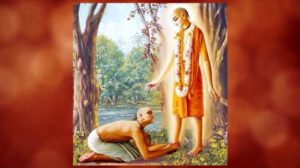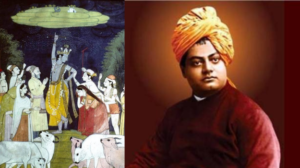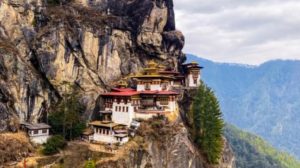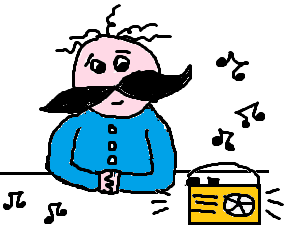The following summary of the Mahabharata was presented by India’s great spiritual mind Swami Vivekananda, before an American audience in Pasadena, California in the year 1900. In this engaging narration Swami Vivekananda recounts the entire story of the Mahabharata, the second of India’s two great ancient epics (the first being the Ramayana) comprising over 100,000 verses and spanning 18 Volumes.
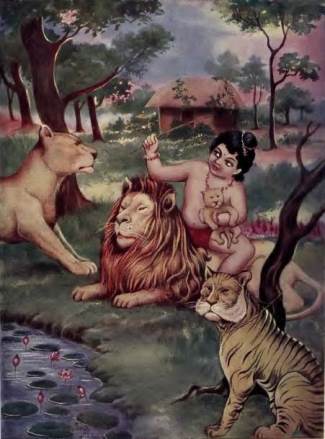
(Courtesy: Mahabharata in Hindi by Gita Press, Gorakhpur)
Introduction
The other epic about which I am going to speak to you this evening, is called the Mahabharata. It contains the story of a race descended from King Bharata, who was the son of Dushyanta and Shakuntala.
“Maha” means great, and “Bharata” means the descendants of Bharata, from whom India has derived its name, Bharata. Mahabharata [therefore] means Great India, or the story of the great descendants of Bharata.
The scene of this epic is the ancient kingdom of the Kurus, and the story is based on the great war which took place between the Kurus and the Panchalas. So the region of the quarrel is not very big. This epic is the most popular one in India; and it exercises the same authority in India as Homer’s poems did over the Greeks.
As ages went on, more and more matter was added to it, until it has become a huge book of about a hundred thousand couplets. All sorts of tales, legends and myths, philosophical treatises, scraps of history, and various discussions have been added to it from time to time, until it is a vast, gigantic mass of literature; and through it all runs the old, original story.
The central story of the Mahabharata is of a war between two families of cousins, one family, called the Kauravas, the other the Pandavas — for the empire of India.
The Aryans came into India in small companies. Gradually, these tribes began to extend, until, at last, they became the undisputed rulers of India. And then arose this fight to gain the mastery, between two branches of the same family.
Those of you who have studied the Gita know how the book opens with a description of the battlefield, with two armies arrayed one against the other. That is the war of the Mahabharata.
[Note: The Aryan invasion theory has now been amply debunked (see here, here and here ), but at the time of Swami Vivekananda this theory was the prevalent world view. Now even though Swami Vivekananda has mentioned the Aryan invasion theory here, in another talk he had also detailed his serious reservations about its validity.]
Pandu & Dhritarashtra
There were two brothers, sons of the emperor. The elder one was called Dhritarashtra, and the other was called Pandu. Dhritarashtra, the elder one, was born blind.
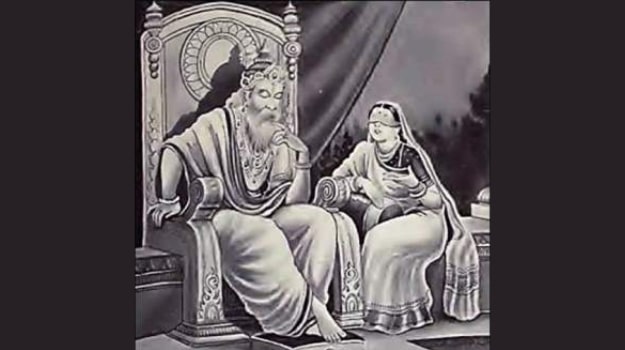
(Courtesy: Mahabharata in Hindi by Gita Press)
According to [ancient] Indian law, no blind, halt, maimed, consumptive, or any other constitutionally diseased person, can inherit. He can only get a maintenance. So, Dhritarashtra could not ascend the throne, though he was the elder son, and Pandu became the emperor.
Dhritarashtra had a hundred sons, and Pandu had only five. After the death of Pandu at an early age, Dhritarashtra became king of the Kurus and brought up the sons of Pandu along with his own children.
When they grew up they were placed under the tutorship of the great priest-warrior, Drona, and were well trained in the various material arts and sciences befitting princes.
The education of the princes being finished, Dhritarashtra put Yudhishthira, the eldest of the sons of Pandu, on the throne of his father. The sterling virtues of Yudhishthira and the valour and devotion of his other brothers aroused jealousies in the hearts of the sons of the blind king, and at the instigation of Duryodhana, the eldest of them, the five Pandava brothers were prevailed upon to visit Varanavata, on the plea of a religious festival that was being held there.
Duryodhana’s Evil Plan
There they were accommodated in a palace made under Duryodhana’s instructions, of hemp, resin, and lac, and other inflammable materials, which were subsequently set fire to secretly.
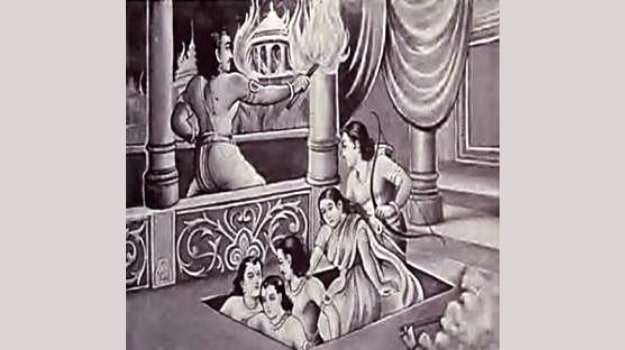
(Courtesy: Mahabharata by Gita Press)
But the good Vidura, the step-brother of Dhritarashtra, having become cognizant of the evil intentions of Duryodhana and his party, had warned the Pandavas of the plot, and they managed to escape without anyone’s knowledge.
When the Kurus saw the house was reduced to ashes, they heaved a sigh of relief and thought all obstacles were now removed out of their path. Then the children of Dhritarashtra got hold of the kingdom.
The five Pandava brothers had fled to the forest with their mother, Kunti. They lived there by begging, and went about in disguise giving themselves out as Brahmana students.
Many were the hardships and adventures they encountered in the wild forests, but their fortitude of mind and strength and valour made them conquer all dangers. So things went on until they came to hear of the approaching marriage of the princess of a neighbouring country.
Svayamvara of Draupadi
I told you last night of the peculiar form of the ancient Indian marriage. It was called Svayamvara, that is, the choosing of the husband by the princess.
A great gathering of princes and nobles assembled, amongst whom the princess would choose her husband. Preceded by her trumpeters and heralds she would approach, carrying a garland of flowers in her hand.
At the throne of each candidate for her hand, the praises of that prince and all his great deeds in battle would be declared by the heralds. And when the princess decided which prince she desired to have for a husband, she would signify the fact by throwing the marriage-garland round his neck. Then the ceremony would turn into a wedding.
King Drupada was a great king, king of the Panchalas, and his daughter, Draupadi, famed far and wide for her beauty and accomplishments, was going to choose a hero.
At a Svayamvara there was always a great feat of arms or something of the kind. On this occasion, a mark in the form of a fish was set up high in the sky; under that fish was a wheel with a hole in the centre, continually turning round, and beneath was a tub of water.
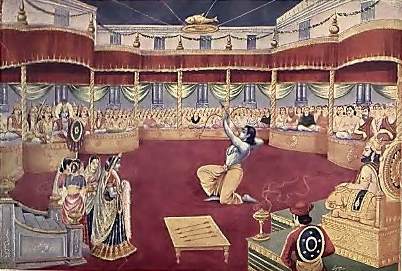
(Courtesy: Mahabharata in Hindi by Gita Press)
A man looking at the reflection of the fish in the tub of water was asked to send an arrow and hit the eye of the fish through the Chakra or wheel, and he who succeeded would be married to the princess.
Now, there came kings and princes from different parts of India, all anxious to win the hand of the princess, and one after another they tried their skill, and every one of them failed to hit the mark.
You know, there are four castes in India: the highest caste is that of the hereditary priest, the Brahmana; next is the caste of the Kshatriya, composed of kings and fighters; next, the Vaishyas, the traders or businessmen, and then Shudras, the servants. Now, this princess was, of course, a Kshatriya, one of the second caste.
When all those princes failed in hitting the mark, then the son of King Drupada rose up in the midst of the court and said: “The Kshatriya, the king caste has failed; now the contest is open to the other castes. Let a Brahmana, even a Shudra, take part in it; whosoever hits the mark, marries Draupadi.”
Mahabharata Summary Continued | NEXT: Arjuna Wins Draupadi’s Hand & Duryodhana Plays a Vile Trick to Usurp the Pandavas Kingdom >>

